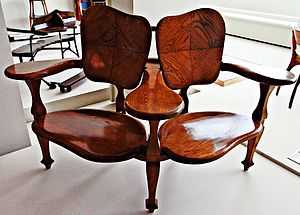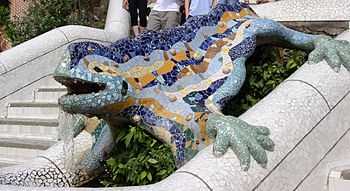Confidant from the Batlló House
 | |
| Artist | Antoni Gaudí |
|---|---|
| Year | 1904-1906 |
| Type | ash wood |
| Location | Museu Nacional d'Art de Catalunya, Barcelona |
The Confidant from the Casa Batlló is a furniture piece designed by Antoni Gaudí and exhibited at the National Art Museum of Catalonia, in Barcelona.
Description
The Confidant, or Double Sofa, was designed by Gaudi, who was known as one of the foremost architects of the late nineteenth and early twentieth century. This chair, intended for Casa Batlló on Passeig de Gracia in Barcelona, Spain, is now housed in the Modern Art collection of the Museu Nacional d'Art de Catalunya, and at Casa Museu Gaudí. The Confidant is a prime example of how the designer "aimed at rounded forms to fit the human form,[1] foregoing upholstery and the superfluous ornamentation of the time and stripping the item bare. Gaudí was a forerunner of ergonomic design, breaking with academic repertories and foreshadowing industrial design, the same as contemporary architects such as Victor Horta, Mackintosh and Saarinen."[2]
"The chairs from the Batlló House, propose a type of seating, hitherto unknown, which seeks after the rounded forms that might adjust to the human body. Executed in the Casas i Bardes workshops in ash wood, they have anatomical shapes which seem to be modelled from the imprint the body makes when seated. Similarly, Gaudi forgoes all reference to style in order to leave the shape unadorned, emphasising the grain and textural qualities of the wood and setting aside the upholstery and superfluous ornamentation, frequently based on floral stylisation, that contemporary decorators like Gaspar Homar and Joan Busquets often went in for."[3]
Gaudí
Antoni Gaudí (Catalan pronunciation: [ənˈtɔni ɣəwˈði]; 25 June 1852–10 June 1926) was a Spanish Catalan architect and figurehead of Catalan Modernism. Gaudí's works reflect his highly individual and distinctive style and are largely concentrated in the Catalan capital of Barcelona, notably his magnum opus, the Sagrada Família.
Much of Gaudí's work was marked by his four life passions: architecture, nature, religion and love for Catalonia.[4] Gaudí studied every detail of his creations, integrating into his architecture a series of crafts in which he was skilled: ceramics, stained glass, wrought ironwork forging and carpentry. He introduced new techniques in the treatment of materials, such as trencadís, made of waste ceramic pieces.
After a few years under the influence of neo-Gothic art and Oriental techniques, Gaudí became part of the Catalan Modernista movement which was reaching its peak in the late 19th and early 20th centuries. His work transcended mainstream Modernisme, culminating in an organic style inspired by nature. Gaudí rarely drew detailed plans of his works, instead preferring to create them as three-dimensional scale models and molding the details as he was conceiving them.
Gaudí’s work enjoys widespread international appeal and many studies are devoted to understanding his architecture. Today, his work finds admirers among architects and the general public alike. His masterpiece, the still-uncompleted Sagrada Família, is one of the most visited monuments in Spain.[5] Between 1984 and 2005, seven of his works were declared World Heritage Sites by UNESCO. Gaudí’s Roman Catholic faith intensified during his life and religious images permeate his work. This earned him the nickname "God's Architect"[6] and led to calls for his beatification.[7][8][9]
Art Nouveau
Art Nouveau is an international philosophy[10] and style of art, architecture and applied art—especially the decorative arts—that were most popular during 1890–1910.[11] The name "Art Nouveau" is French for "new art". A reaction to academic art of the 19th century, it was inspired by natural forms and structures, not only in flowers and plants but also in curved lines. Architects tried to harmonize with the natural environment. It is also considered a philosophy of design of furniture, which was designed according to the whole building and made part of ordinary life.[12]
In Spain, the style was based mainly in Barcelona and was an essential element of the Catalan Modernisme, often understood as an equivalent to a number of fin-de-siècle art movements, such as Art Nouveau, Jugendstil, Secessionism, and Liberty style. Architect Antoni Gaudí, whose decorative architectural style is so personal that he is sometimes considered as practising an artistic style different from Art Nouveau, nonetheless uses Art Nouveau's floral and organic forms.[13] His designs from about 1903, the Casa Batlló (1904–1906) and Casa Milà (1906–1908), are most closely related to the stylistic elements of Art Nouveau.[14] However, famous structures such as the Sagrada Familia characteristically contrast the modernising Art Nouveau tendencies with revivalist Neo-Gothic.[14]
Further examples of Gaudi's work
-

Sagrada Familia
-

Trencadís in Parc Güell
-

Organic Forms in Casa Batlló
References
- ↑ Arquebisbat de Barcelona (2002) Gaudi: the man and his work, Museu Diocesa de Barcelona, p.126
- ↑ MNAC Website
- ↑ Museu Nacional d'Art de Catalunya (2005), Guide, p. 262.
- ↑ Quiroga, Eduardo Daniel; Salomón, Eduardo Alberto. "Gaudí: Mecánica y forma de la naturaleza". Arquba.com (in Catalan). Archived from the original on 15 October 2011. Retrieved 29 August 2008.
- ↑ Torres, I. Álvarez. "La Sagrada Familia de Barcelona ultima los preparativos para su apertura al culto" (in Catalan). Lavoz Digital. Archived from the original on 16 October 2011. Retrieved 3 August 2008.
- ↑ Tremlett, Giles (11 July 2003). "God's architect on road to sainthood". The Guardian. UK. Archived from the original on 16 October 2011. Retrieved 21 April 2011.
- ↑ ""God's architect" on the path to sainthood". The Times (UK). 9 November 2009. Archived from the original on 16 October 2011. Retrieved 20 April 2011.
- ↑ Klettner, Andrea (4 November 2010). "Pope's visit could fast-track Gaudí sainthood". Bdonline.co.uk. Archived from the original on 16 October 2011. Retrieved 21 April 2011.
- ↑ (Puig i Tàrrech 2010, p. 66)
- ↑ Duncan (1994), 7.
- ↑ Sterner (1982), 6.
- ↑ Art Nouveau – Art Nouveau Art
- ↑ James Grady, "Special Bibliographical Supplement: A Bibliography of the Art Nouveau", The Journal of the Society of Architectural Historians, vol. 14 (May, 1955), pp. 18–27.
- ↑ 14.0 14.1 Duncan (1994): 52.
Further reading
- Robinson, W., Falgas, J., & Lord, C.B. (2007) Barcelona and Modernity: Picasso, Gaudi, Miro, Dali. Cleveland Museum of Art in Association with Yale University Press, New Haven and London.
- Hyogo Prefectural Museum of Modern Art, Kobe; The Museum of Modern Art, Kamakura; The Museum of Fine Arts, Gifu (1987) Homage to Catalonia, Barcelona Art City, The Committee of Exhibition.
External links
- Confidant on MNAC website
- Google Art Project Feature of Confidant
- MNAC YouTube presentation of Confidant
| ||||||||||||||||||||||||


